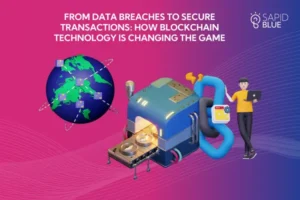Bitcoin, introduced to the world in 2009, served as the first practical implementation of blockchain technology. It demonstrated a novel use case beyond traditional financial systems – a decentralized digital currency free from central authority control. Bitcoin’s success lies in its ability to facilitate secure, peer-to-peer transactions on a global scale, leveraging blockchain’s decentralized ledger for transparent and immutable record-keeping. This groundbreaking application not only highlighted blockchain’s potential in redefining financial transactions but also set the stage for exploring the technology’s broader implications across various sectors.
As we go deeper into understanding how blockchain works beyond just Bitcoin, it’s clear that this technology has the power to change many parts of our online and offline lives. Blockchain isn’t just about digital money anymore – it can do a lot more. Exploring the benefits of blockchain and how it can improve business processes, along with the growing field of blockchain development services, shows how versatile this technology is. It can make things work better in many different industries. Moving from Bitcoin to lots of practical uses shows that we’re entering an exciting time for blockchain. It promises to make digital transactions and other things more efficient, secure, and transparent.
1. Understanding Blockchain Technology
Blockchain technology has emerged as a revolutionary force, far transcending its initial application in powering cryptocurrencies like Bitcoin. Its distinctive architecture and operational mechanism offer a plethora of benefits, making it an invaluable asset across diverse sectors. Let’s delve into the foundational aspects of blockchain technology, exploring its decentralized nature, core components, and key features that collectively promise to transform the landscape of business opetrations and blockchain development services.

a) The Decentralized Nature of Blockchain
At its heart, blockchain technology is inherently decentralized. Unlike traditional systems that rely on a central authority for governance and validation, blockchain operates on a peer-to-peer network. This means that data, once entered into the blockchain, is distributed across multiple nodes, ensuring no single point of failure. This decentralization not only enhances security but also promotes a democratic and transparent operational model. It significantly reduces the risk of manipulation and fraud, making blockchain a trustless system where transactions can be verified and validated by consensus among participants.
b) Core Components of a Blockchain
Blockchain’s architecture is built on three fundamental components: blocks, nodes, and consensus mechanisms.
Blocks: These are the basic units of a blockchain. Each block contains a collection of transactions that are securely hashed and encoded. Every new block created is linked to the previous block, forming a chain of blocks or a blockchain. This linkage ensures the integrity and chronological order of transactions.
Nodes: The backbone of the blockchain network, nodes are individual computers that hold a copy of the entire blockchain. They are responsible for validating and relaying transactions. Nodes operate under a consensus mechanism to agree on the validity of transactions, ensuring that each copy of the distributed ledger is identical.
Consensus Mechanisms: These are protocols that achieve agreement among the network’s nodes on the true state of the blockchain ledger. Common consensus mechanisms include Proof of Work (PoW) and Proof of Stake (PoS), each with its unique way of ensuring transactions are legitimate and preventing malicious activities.
c) Key Features: Immutability, Transparency, and Security
Blockchain technology is synonymous with immutability, transparency, and unparalleled security, making it particularly appealing for blockchain for business applications.
Immutability: Once a transaction is recorded on a blockchain, it is nearly impossible to alter. This immutable nature ensures that every transaction on the blockchain is secure and permanent, offering a verifiable and accurate history of transactions.
Transparency: With blockchain, transactions are transparent yet secure. While personal information remains private, the transaction data is available to all participants. This level of transparency builds trust among users and ensures that every action on the blockchain is accountable and traceable.
Security: Blockchain’s decentralized structure and cryptographic hash functions make it extremely secure against hacking and fraudulent activities. The consensus models further fortify the network, making it resilient to attacks and unauthorized alterations.
2. The Rise of Alternative Blockchain Use Cases
The narrative surrounding blockchain technology has largely been tethered to Bitcoin and the broader cryptocurrency space. However, the potential of blockchain extends far beyond the confines of digital currencies. This transformative technology harbors the promise of revolutionizing a multitude of sectors by offering unprecedented security, transparency, and efficiency. In this section, we delve into the versatility of blockchain technology and explore its practical applications across various industries.
a) Blockchain’s Versatility Beyond Cryptocurrency
Blockchain technology is a decentralized digital ledger that records transactions across multiple computers in such a way that the registered transactions cannot be altered retroactively. This foundational attribute of blockchain, coupled with its inherent security, immutability, and transparency, makes it an attractive proposition for businesses seeking to enhance operational efficiency, reduce costs, and bolster data integrity.
- Supply Chain Management: In the realm of supply chain management, blockchain offers a compelling solution to age-old challenges such as counterfeiting, supply chain opacity, and inefficiencies. By leveraging blockchain, businesses can create a transparent and unalterable record of the journey of goods from production to delivery, ensuring traceability and authenticity. This heightened visibility not only enhances consumer trust but also optimizes the supply chain by identifying bottlenecks and reducing reliance on intermediaries.
- Healthcare: Blockchain technology promises to redefine the healthcare industry by ensuring the integrity, security, and interoperability of health records. It enables the creation of a unified, tamper-proof database of patient records that can be securely shared among authorized stakeholders, thus improving the quality of care, enhancing patient outcomes, and ensuring data privacy and security.
- Finance and Banking: The finance and banking sector stands to benefit significantly from blockchain development services. Blockchain can streamline payments, facilitate faster transactions that are secure and transparent, and reduce costs by eliminating the need for third-party verification. Moreover, blockchain introduces the possibility of smart contracts — self-executing contracts with the terms of the agreement directly written into lines of code — thereby simplifying and securing financial transactions and agreements.
- Real Estate: Blockchain is set to revolutionize the real estate sector by making transactions more straightforward, secure, and efficient. Through blockchain, the entire history of a property, including title details, transfers, and mortgages, can be securely recorded and easily accessed, reducing fraud and speeding up the real estate transaction process.
- Voting Systems: Blockchain technology can address many concerns associated with voting systems, such as security, voter privacy, and vote tampering. By providing a secure and transparent digital ledger, blockchain can facilitate secure online voting systems where votes can be accurately and anonymously recorded.
- Intellectual Property Rights and Identity Verification: Blockchain also has profound implications for managing intellectual property rights and identity verification. It offers an immutable record of ownership and licensing agreements for intellectual property, making it easier to protect and manage assets digitally. Similarly, blockchain can provide a secure and unforgeable means of identity verification, thereby reducing identity theft and fraud.
3. Benefits of Utilizing Blockchain Technology
The advent of blockchain technology has ushered in a new era of digital transformation, extending far beyond its initial application in Bitcoin. This revolutionary technology offers a myriad of benefits, promising to redefine the operational frameworks of various industries. By enhancing efficiency, reducing costs, bolstering security, and opening doors to innovation, blockchain stands at the forefront of technological advancement. Let’s delve into the tangible benefits of utilizing blockchain technology.

a) Efficiency Improvements Through Automation and Transparency
Blockchain technology is synonymous with automation and transparency, two critical attributes that significantly contribute to operational efficiency. By automating processes that were traditionally manual and time-consuming, businesses can achieve faster transactions and streamlined workflows. Moreover, the inherent transparency of blockchain ensures that all transactions are visible and traceable in real-time. This not only reduces the likelihood of errors but also fosters trust among stakeholders. Industries such as supply chain management have already begun reaping the benefits of blockchain by enhancing visibility and efficiency across their operations.
b) Cost Reduction Through Elimination of Intermediaries
One of the most compelling advantages of blockchain is its potential to dramatically reduce costs by eliminating the need for intermediaries. In traditional business models, third parties such as banks and other financial institutions often act as middlemen in transactions, leading to increased costs and delays. Blockchain, with its decentralized nature, allows for peer-to-peer transactions without the need for intermediaries, resulting in significant cost savings and expedited processes. This aspect of blockchain is particularly transformative in sectors like finance and banking, where blockchain for business is not just a buzzword but a practical tool for cost optimization.
c) Enhanced Security and Trust in Data Integrity
In an era where data breaches and cyber-attacks are rampant, blockchain offers an unprecedented level of security and trust. The technology’s immutable ledger ensures that once a transaction is recorded, it cannot be altered or deleted, thus safeguarding the integrity of data. Furthermore, blockchain’s decentralized structure mitigates the risk of centralized points of failure, making it exceedingly difficult for hackers to compromise the system. These security features make blockchain an attractive option for industries handling sensitive information, such as healthcare and finance, where data integrity is paramount.
d) Potential for New Business Models and Revenue Streams
Blockchain technology is not just about enhancing existing processes; it’s also about innovation and exploring uncharted territories. By leveraging blockchain, businesses can explore new models and revenue streams that were previously inconceivable. From creating decentralized applications to facilitating secure and transparent voting systems, the possibilities are endless. Furthermore, the advent of blockchain development services has made it easier for businesses to tailor blockchain solutions to their specific needs, fostering innovation across various sectors.

4. Overcoming Challenges and Limitations
As the application of blockchain technology transcends the realm of Bitcoin, transforming into a foundational technology for various industries, it’s paramount to address its challenges and limitations. In this journey towards mainstream adoption, four primary hurdles stand out: scalability, regulatory compliance, interoperability, and environmental impact. Let’s delve into each of these challenges, shedding light on the solutions being developed and the implications for businesses seeking blockchain development services.
a) Scalability Issues and Solutions Being Developed
One of the most significant challenges facing blockchain technology is scalability. As blockchain networks grow in size and usage, they often struggle to process transactions quickly and efficiently, leading to bottlenecks and increased transaction costs. This is particularly evident in the context of public blockchains, where the number of transactions per second is a fraction of what traditional centralized systems can handle.
To address this, blockchain developers are innovating with solutions like Layer 2 protocols, sharding, and consensus mechanism improvements. Layer 2 solutions, such as Lightning Network for Bitcoin, operate on top of the blockchain to enable faster and cheaper transactions. Sharding divides the blockchain into smaller, manageable pieces, allowing for parallel processing. Moreover, the transition from energy-intensive consensus mechanisms like Proof of Work to more efficient ones like Proof of Stake is also a significant step towards enhancing scalability.
b) Regulatory Challenges and Compliance Considerations
Blockchain technology operates in a legal and regulatory grey area, with many countries still formulating their stance on cryptocurrencies and blockchain applications. For businesses leveraging blockchain for transparency, efficiency, or decentralization, navigating the evolving regulatory landscape is crucial.
Compliance with Know Your Customer (KYC) and Anti-Money Laundering (AML) regulations is paramount, especially for blockchain platforms involved in financial transactions. Blockchain development services must prioritize building platforms that not only meet current regulatory standards but are also adaptable to future changes in legislation. Collaborating with regulatory bodies and participating in blockchain standardization efforts can help in mitigating these challenges.
c) Interoperability Between Different Blockchain Platforms
The burgeoning blockchain ecosystem comprises numerous platforms, each with its unique features and capabilities. However, the lack of interoperability among these platforms can hinder the seamless exchange of information and value, limiting the potential for collaborative innovation.
To overcome this, the development of cross-chain protocols and blockchain bridges is gaining momentum. These technologies enable the transfer of assets and data across different blockchain networks, fostering a more integrated and efficient ecosystem. For businesses, this means greater flexibility in choosing blockchain solutions that best fit their needs, without being confined to a single platform.
d) Environmental Concerns Related to Energy Consumption
The environmental impact of blockchain, especially those employing Proof of Work (PoW) consensus mechanisms, cannot be overlooked. The substantial energy consumption associated with mining activities has drawn criticism and calls for more sustainable practices.
In response, the industry is exploring alternative consensus mechanisms, such as Proof of Stake (PoS), which significantly reduce energy consumption. Furthermore, the advent of green blockchain initiatives and carbon offsetting practices demonstrates a commitment to environmental sustainability. Blockchain development services focusing on eco-friendly practices can not only alleviate environmental concerns but also appeal to a growing segment of environmentally conscious stakeholders.
5. Future Trends and Opportunities
As we delve deeper into the realm of blockchain technology, its horizon continues to expand beyond the foundational cryptocurrency, Bitcoin. This revolutionary technology has not only transformed the way we perceive digital transactions but also opened avenues for myriad applications across various industries. Let’s explore the emerging trends, the burgeoning areas of innovation, and the promising role of decentralized finance (DeFi) and non-fungible tokens (NFTs) in shaping the future of blockchain technology. Moreover, we will shed light on the potential for mainstream integration of blockchain across different sectors.
a) Emerging Trends Shaping the Future of Blockchain Technology
The landscape of blockchain technology is constantly evolving, with new advancements emerging at a rapid pace. One significant trend is the shift towards more sustainable and energy-efficient blockchain networks. As concerns over the environmental impact of traditional blockchain systems grow, the development of green blockchain solutions that offer lower energy consumption without compromising on security or efficiency is gaining traction.
Another trend to watch is the rise of Blockchain as a Service (BaaS) platforms. These platforms offer blockchain development services, making it easier for businesses to adopt and implement blockchain technology without the need for in-depth expertise. BaaS platforms are democratizing access to blockchain technology, enabling small and medium-sized enterprises (SMEs) to leverage blockchain benefits for enhanced transparency, security, and efficiency.
b) Potential Areas for Further Innovation and Adoption
Blockchain technology harbors the potential to revolutionize a wide array of sectors. In the realm of supply chain management, blockchain can offer unparalleled transparency, enabling consumers to trace the journey of a product from its origin to the shelf. Similarly, in healthcare, blockchain can secure patient data, facilitating seamless and secure access to medical records for both patients and healthcare providers.
Another promising area is the integration of blockchain in governmental operations. From land registry systems to voting mechanisms, blockchain can enhance transparency, reduce fraud, and streamline processes, thereby fostering trust in public systems.
c) Role of Decentralized Finance and Non-Fungible Tokens (NFTs)
Decentralized Finance and Non-Fungible Tokens (NFTs) represent two of the most innovative applications of blockchain technology. DeFi is redefining the financial landscape by offering decentralized alternatives to traditional financial services, including lending, borrowing, and trading. This democratization of finance eliminates intermediaries, reduces costs, and increases accessibility.
NFTs, on the other hand, are transforming the art and entertainment industries. By enabling the digital representation of assets, NFTs allow for the ownership, sale, and purchase of unique digital items, from artwork to collectibles. The transparency and security of blockchain ensure the authenticity and scarcity of these digital assets, opening new revenue streams for creators and artists.
d) Predictions for the Mainstream Integration of Blockchain in Various Sectors
The future of blockchain technology holds immense promise for mainstream adoption. As blockchain development services continue to evolve, we can anticipate broader integration of blockchain in sectors such as finance, healthcare, real estate, and beyond. The key drivers for this widespread adoption will be the continuous improvement of blockchain infrastructure, increased regulatory clarity, and the growing recognition of blockchain benefits among businesses and consumers alike.
The journey of blockchain technology, from powering Bitcoin to enabling a wide array of blockchain for business applications, underscores its transformative potential. As we look toward the future, it is clear that blockchain will play a pivotal role in shaping the digital landscape, driving innovation, and fostering a more transparent, secure, and efficient world.
Conclusion
In conclusion, as we stand on the brink of this digital revolution, it’s clear that blockchain technology extends well beyond its roots in cryptocurrency. Its benefits for businesses, coupled with the transformative potential of blockchain development services, herald a new era of digital innovation. The journey of blockchain is just beginning, and its full potential is yet to be unleashed. As we look forward to a future shaped by blockchain technology, one thing is certain: the impact of blockchain will be profound, reshaping industries, economies, and societies in ways we are just beginning to understand.
FAQs
1. What is blockchain technology beyond Bitcoin?
Blockchain technology extends beyond Bitcoin by offering decentralized digital ledgers with various applications. While Bitcoin was the first practical use case, blockchain now promises to transform multiple sectors with its secure, transparent, and immutable record-keeping capabilities.
2. What are the core components of blockchain technology?
Blockchain comprises blocks, nodes, and consensus mechanisms. Blocks contain transaction data, nodes validate and relay transactions, and consensus mechanisms ensure agreement among network nodes on the blockchain’s true state.
3. What are the key features of blockchain technology?
Blockchain is characterized by immutability, transparency, and security. Transactions recorded on the blockchain are secure and permanent, visible to all participants while maintaining privacy, and highly resistant to hacking and fraud due to its decentralized structure.
4. How versatile is blockchain technology beyond cryptocurrency?
Blockchain technology has diverse applications, including supply chain management, healthcare, finance, real estate, voting systems, and intellectual property rights management. It enhances transparency, security, and efficiency across various industries.
5. What are the benefits of utilizing blockchain technology?
Utilizing blockchain technology leads to efficiency improvements through automation and transparency, cost reduction by eliminating intermediaries, enhanced security, and trust in data integrity, and the potential for new business models and revenue streams.






